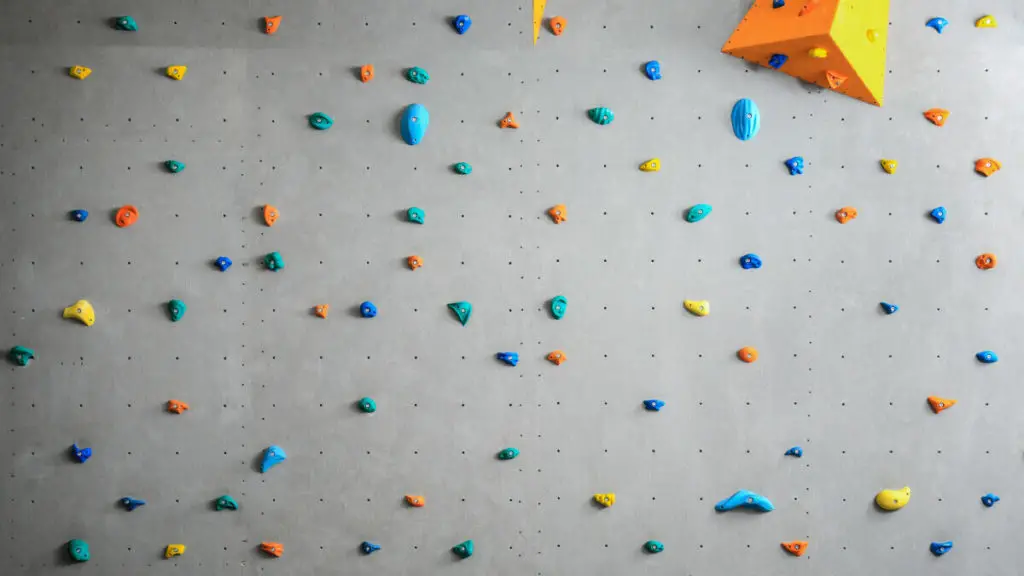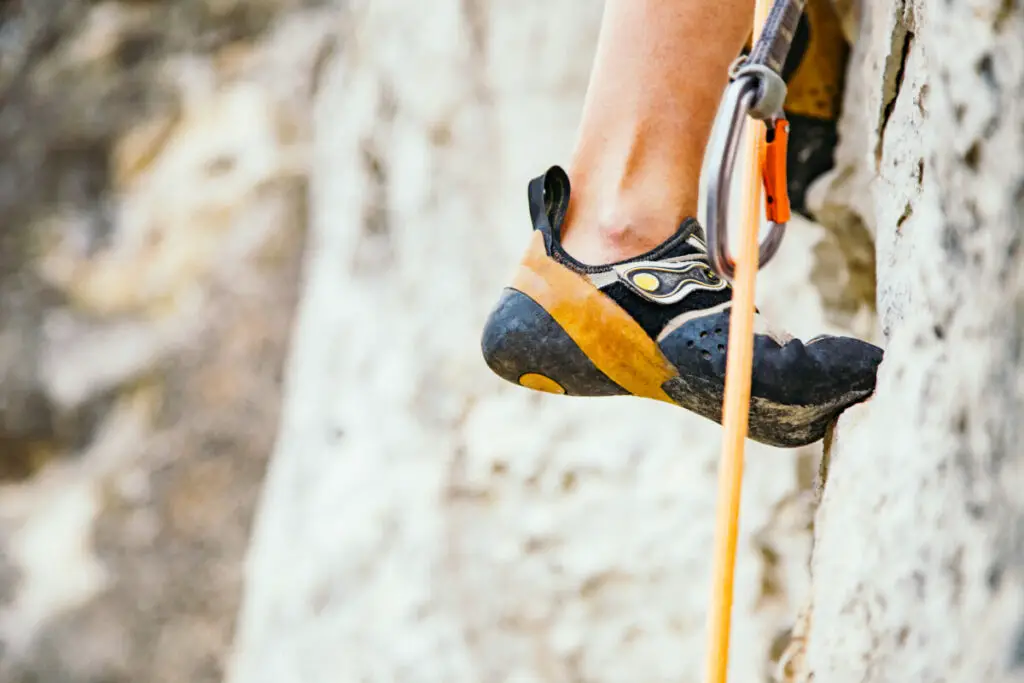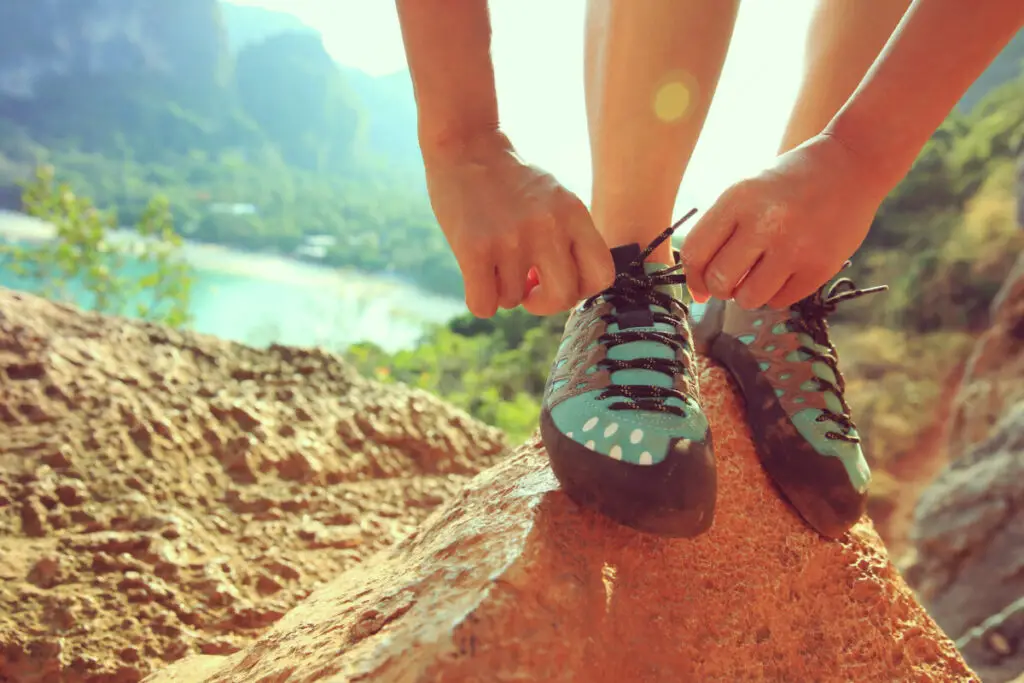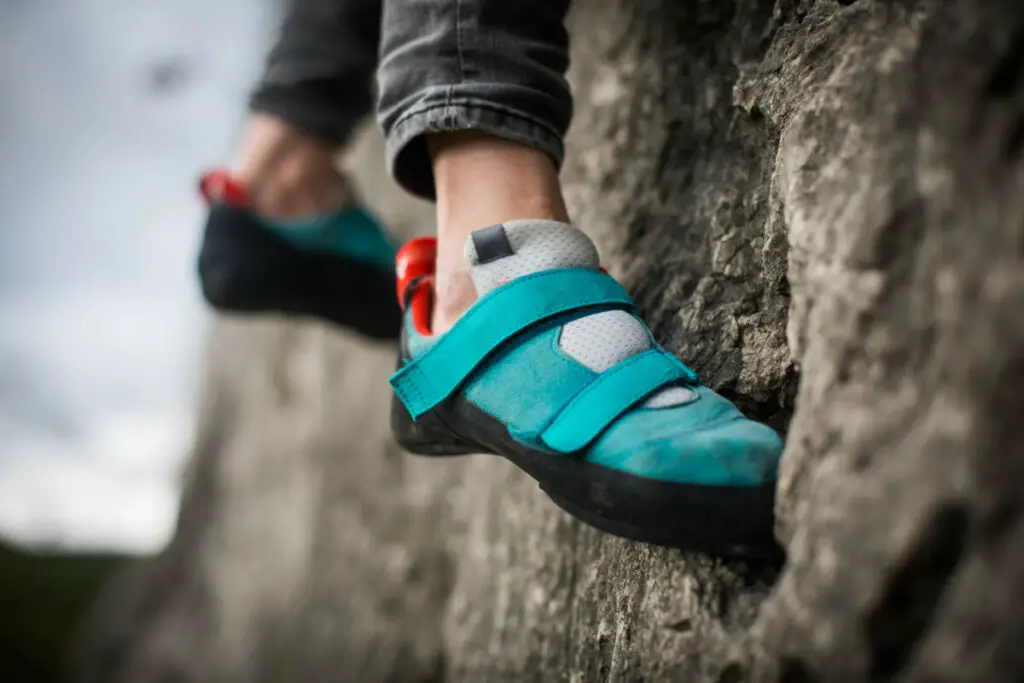
This can be simply answered by answering a more general question: do I need special rock climbing shoes? The answer is yes. Anyone looking to climb with any amount of regularity, beginner or seasoned, should absolutely wear climbing-specific shoes for both safety and maneuverability.
Climbing shoes for beginners have different qualities from shoes for more experienced climbers. Beginner shoes should support the new climber’s foot to prepare them to eventually move on to more difficult climbing terrain, but shouldn’t be so drastically shaped as shoes for more seasoned climbers.
The exact shape and stiffness best suited to a beginner climber’s shoe depends on the type of climbing the adventurer plans on doing most. Believe it or not, sizing may also change slightly for the same reason. Let’s take a look at the different climbing styles and how they affect the kind of shoe you aim for.
Do My Shoes Really Matter When Climbing?
Before getting into the specifics of climbing shoes, let’s address why exactly it is important to have them. Rock climbing can be a very fun and rewarding experience, but it does not come without its dangers. Climbers of all skill sets know to take precautions when climbing to ensure their safety. These precautions include helmets, harnesses, ropes, and yes, climbing shoes.
Think about it: you would not want to go parachuting without goggles, the force of the wind would blind you and dry out your eyes, restricting your ability to know when to pull the chute. In climbing, your footwear performs a similar function: providing your feet with the protection and support they need for you to be able to safely maneuver over the rocks. Wearing improper footwear— going out without all the proper safety gear— can put any climber, especially an inexperienced one, in unnecessary danger.
What Does a Beginner Climbing Shoe Look Like?

Climbing shoes for any level of expertise are going to look different based on what kind of climbing you intend to do with them. Everything including size, material, fasteners, rigidity, and shape all has an effect on which environments the shoe will be most helpful in.
Rigid shoes with extremely high arches— the kind that look a bit like bananas and are very tight on the feet— are useful for climbs with very narrow footing and thin edges. The exaggerated curve makes it easier to distribute the climber’s weight over a very small foothold. Shoes with softer form and less exaggerated shape are more suited to crack climbing where flexibility of the foot is necessary to maneuver through tight spaces.
That being said, beginner climbers do not have the exact same needs as more experienced climbers, although the type of climbing you want to work your way up to can influence some of the shoe style they select to begin with. In general, it is good to start off with a shoe that is durable and has a high level of comfort. Skill comes from practice— lots of practice.
Beginner climbing shoes are generally also the flattest of most shoes. The more rounded or curved designs, suited to more technical climbing come later. A beginner pair of climbing shoes should be able to support you as you develop your skills as a climber, leaving you free to hone your technique without dropping more money on shoes as they wear out before moving up to a shoe for more skilled climbers.
Lists of top-rated beginner shoes all outline several attributes for each shoe on their list. Going off this data, the most important attributes a pair of beginner climbing shoes should have include durability, comfort, and simplicity. Beyond those basic features, the shape and make of each shoe covers a wide range. As your skills as a climber develop, it may be helpful to have a pair of shoes that can handle more varied terrain than just the gym. That being said, let’s look at some of the attributes that determine a shoe’s abilities.
Indoor vs Outdoor Climbing Shoes

As previously mentioned, the environment you plan to do most of your climbing in determines a lot about what your climbing shoes should look like. As a new climber, you will likely spend at least some time in a gym before venturing into the great outdoors for more complex or varied climbs. It is important to have an idea of where you eventually want to spend most of your climbing time.
Shoes intended mainly for gym climbing benefit from thick soles as they will go through more routes over a shorter period of time, wearing them out faster. However, that is not to say that outdoor shoes need not have the same durability, as the conditions they face will frequently be grittier.
For climbers who plan to do most of their climbing indoors at a gym, a shoe that is comfortable and durable is going to be preferred, as indoor climbers tend to log more climbing over a shorter period of time than outdoor climbers. Curvature is not as important as a shoe that can handle lots of use. Climbing shoes that have more flexibility are well-suited to gym climbing, allowing you to build foot strength and technique as you progress.
Climbing shoes typically have laced, velcro, or slip-on closings. Velcro-closing shoes are also better suited to indoor climbers, as they make for easy and fast access. Slip-ons are also an option for beginners, but are not as highly recommended, as there is no way to adjust the shoe to a person’s foot. This can cause issues over time as the shoe stretches with wear. Lace-closing shoes are another good option, but may be more convenient for outdoor climbing, being more secure than either velcro or slip-on.
Because outdoor climbing can be rougher and requires more precision than indoor climbing, shape (or camber) becomes more important. Shoes with stiff soles and a strong downturn provide the control needed to maneuver outdoors. Footholds can be smaller and less uniform in shape, causing more wear and tear to the shoe than the controlled environment of a gym. Having a pair of shoes that can handle the level of technicality will serve you well.
There are a ton of resources available to help you in choosing a good climbing shoe. Employees at sports or climbing stores can offer advice in person. If you are ordering online, there are also buying guides and videos from experienced climbers to help inform your decision.
The Shape of New Climbing Shoes

There are three categories of shape that climbing shoes can fall under: neutral, moderate, and aggressive. Neutral shoes are more relaxed in both shape and fit, and are generally comfortable enough to be worn all day. They are closest to regular shoes in shape, lacking the extreme curve of aggressive shoes. Their midsoles and soles are frequently thick and of a medium stiffness, providing good support and durability. Their adaptability make them a great beginner shoe.
Moderate shoes are identifiable by their slight downturn in shape, allowing an increase in technical capabilities but a decrease in overall comfort. Typically their soles have stickier, thinner rubber than shoes in the neutral category, allowing the climber to better feel and grip their footholds.
These all-purpose shoes can handle a good variety of climbs, though are not as performance-oriented as aggressive shoes. The thinner soles also wear out faster than thicker-soled shoes, making them good for maneuverability, but not necessarily for longevity.
Aggressive shoes are the ones that most people think of when climbing shoes are brought up. They have a strong asymmetric downturn in shape and lots of heel tension, which put your feet in a position with the most power, which is helpful for challenging overhanging climbs but not great for climbs where feet need flexibility to fit into crevices. They are also typically the tightest of all the climbing shoes. Because of the fit and shape, climbers typically use aggressive shoes for single-pitch sport climbs and routes, rather than all-day climbs.
Beginner climbers will want to start with a more neutral shoe, building up skill over time before moving on to progressively more downturned and stiff shoes. Even those who plan to progress quickly, choosing too aggressive of a shoe early on can actually harm your progress or cause injury.
Climbing requires strength and muscles that are not typically used. Footwear helps climbers to build those strengths. Do not rush the process! It is recommended that beginner climbers start out with a softer-soled shoe to develop strength and flexibility before moving on to a stiffer option.
Sizing New Climbing Shoes

Getting the right size in a climbing shoe depends on two things: regular shoe size and last— the foot-shaped model the shoe is based around. The last gives a shoe its width, instep height and volume as well as heel and toe dimensions. Essentially, the last determines the shape of a climbing shoe.
While most climbing shoes are slip-lasted, some are board lasted. The curvature of a climbing shoe is also included in the last, as can be seen in the table below. As everyone’s feet are shaped differently, the specific last of a shoe can change the size a climber needs. Here is a table to help you easily see the different aspects of each type of rock climbing shoe.
| Last Type | Attributes | Good For |
|---|---|---|
| Slip-lasted | Sensitive and less stiff than board-lasted. No insole, get stiffness from midsole. | Most climbing shoes |
| Board-lasted | Sacrifice sensibility of foot, stiffer than slip-lasted. More comfortable. | All-day wear |
| Asymmetric | Longest point over the big toe to increase power of shoe’s inside edge, gives single point of contact to rock. Moderate or aggressive. | Single-Pitch and Technical climbs |
| Downturned | Also called “cambered,” shape bends downward toward toes. Designed for toe and heel hooking. Moderate or aggressive. | Difficult routes requiring maximum control |
| Straight | Built around straight shape. Also called flat last, offer relaxed fit and high comfort. Mostly considered neutral shoes. | Long climbing days and crack climbing |
Because of this, last also influences the kind of closure you pick for your shoe. Some shoes may fit well enough to be secure as simple slip-ons, though, that may not last as the shoe gets more worn out. Velcro closures are unparalleled in terms of ease of use— very popular among gym climbers— and require less effort to adjust than laces.
Their ease of use can be especially helpful when breaking-in a new pair of shoes while your feet are still hurting. The downside to the velcro’s ease is that you are limited in the amount of adjustability you have. Its helpfulness in security is largely limited by the closure design.
Laces are, of course, the old standard for fine-tuned security, and with good reason. They are more precise than velcro, can be adjusted to more easily fit foot and shoe type, and are easily replaceable, whereas with velcro the whole shoe needs to be replaced once it wears out. Laces essentially ensure that the climbing shoe is at its best and most secure fit to your foot. However, they do take the most time to manage out of all the closing methods.
The last thing you want in a climbing shoe is a poor fit. Shoes that are too tight or too loose will only hinder your progress as a climber. Avoid shoe options that have a significant amount of space at the end of the shoe. A well-sized shoe should be snug but also fit comfortably enough to wear for multiple hours at a time. That being said, do not expect rock climbing shoes to be comfortable.
The tighter fit of climbing shoes narrows the point of your foot, gives you a better feel for the rocks, and allows for better maneuverability. As shoe level increases, so will the tightness. Many climbers scale their regular shoe size down from 1.5 to 2 sizes when selecting a climbing shoe. However, you do not have to stay within those specific numbers.
Good climbing shoes should be close-fitting but not restricting. For beginner-level climbers, start off easy with a close-fitted shoe that does not feel too constrictive. As your skill increases, you can opt for tighter, more performance-oriented shoes.

